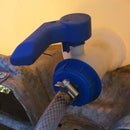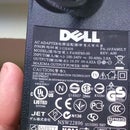Introduction: Micro USB Lithium Charger for Cilindrical Lithium Baterry
I got a green laser from ebay, pretty cheap and it included one piece of 18650 Lithium battery, wall charger for the battery, caring box for the laser etc. This raised a question mark given the price and the number of objects I received.
In one day I wanted to charge my 18650 battery and after a while, I heard something popping, a sound from the wall charger. The magic smoke came out and the charger was not good anymore. I assumed that some sort of capacitor was blown given the smell and the smoke :)
I removed the screws and I found a blown capacitor. My initial thought was to scrap the charger. After a good sleep, I came back to better feelings: I can use the plastic housing of the charger to put inside a nice micro USB lithium charger PCBA.
More details about this micro USB charger you can find from Julian's video: New TP4056 Lithium Cell Charger Module with Battery Protection (this is from ebay - I picked one randomly: Micro USB 1A Lithium Battery Charger Module)
This is pretty straight forward project, follow the not-so-detailed steps.
Benefits:
-you re-purposed an object instead of creating more garbage
-this charger can accommodate various lithium size batteries
-you can charge lithium batteries wherever you have a micro USB connection (car, home, outdoors)
Step 1: Open the Charger
Use a screw driver to open the charger (on mine were 5 Philips screws)
Step 2: Remove the Electronics of the Charger
Remove the electronic board (PCBA) of the charger, desolder the battery contacts from the electronic board and dispose the electronics board on a recycling bin for electronics
Step 3: Make a Rectangular Hole
Check where the micro USB charger PCB will sit inside the plastic housing and make a rectangular hole to match the micro USB connector of the PCB.
I used a red hot screw driver tip to drill that hole and a cutter to remove any burrs. You can do the same for the LEDs, it is not mandatory (you can see the LEDs through the plastic case).
Step 4: Solder Wires
Solder the wires to the micro USB charger and to the metal contacts for the battery. Pay attention to the polarity ("+" and "-").
Connect a micro USB cable to check that the charger is working.
Step 5: Secure Wires and Parts Inside
Now you have a plastic housing, secure the wires and the micro USB lithium charger inside with hot melt / hot glue.
Make sure that the spring is moving free inside.
Step 6: Enjoy Your Charger :)
Put the charger back, fasten the screws and use your new charger! (the blueish spot on the case is created by the LED from the charger)




